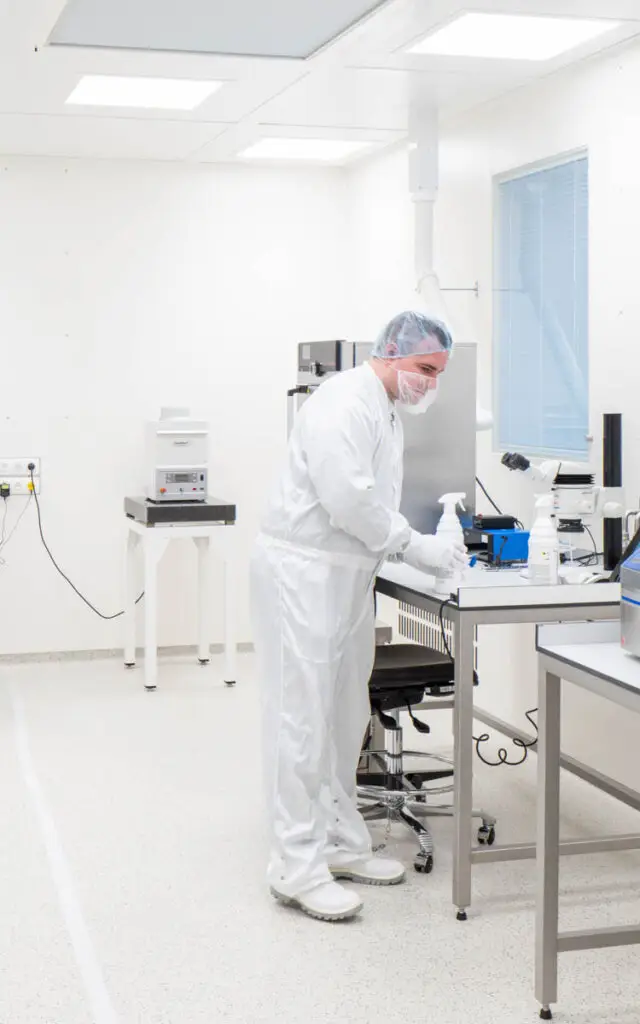Transforming cleanroom complexity into simplicity with ABN’s Product Platform Strategy
Since 2024, ABN Cleanroom Technology redefined the cleanroom industry by introducing ADAPTUS, the world’s first product platform strategy for cleanroom engineering. ADAPTUS organizes critical cleanroom components into modular building blocks, shifting from the traditional Engineering-to-Order approach to a Configure-to-Order model.
Throughout this article, it will become clear why this approach is so important in constantly evolving industries like pharmaceuticals, biotechnology and semiconductor manufacturing. Achieving this level of efficiency and quality is only possible by adopting the Design-Build-Maintain business model.
Product platform strategy vs. traditional construction approaches
To understand what a Product Platform Strategy means, we must first define it. Just like our Cleanroom-as-a-Service framework, this concept originates from the software industry. O’Grady (1999, p.14) provides a concise definition:
“Each module can be complex internally, but with clearly defined interfaces, each module can be linked with other modules in different combinations. An organization can use modularity to produce a wide variety of products in extremely short lead times”.
In simple terms, this approach allows us to adapt quickly, deliver solutions faster, and continuously improve individual components without disrupting the entire system. For ABN Cleanroom Technology, adopting a Product Platform Strategy results in cleanroom solutions with lead times starting from as little as 6 weeks, an achievement unreachable with traditional approaches.
Applied to the cleanroom industry, a Product Platform Strategy facilitates the creation of a broader variety of products while reducing complexity. Because all cleanrooms share the same core components, we increase flexibility, lower costs, and shorten delivery times. The result: up to 20% cost savings, higher efficiency, and a smoother process for clients and partners.
No product platform strategy without a Design - Build - Maintain business model
Design
The traditional Engineer-to-Order (ETO) model requires extensive time and resources in the design phase, often spanning months. As every design starts from scratch, each project demands bespoke engineering, leading to recurring development costs and prolonged timelines.
In contrast, the Configure-to-Order (CTO) model leverages standardized building blocks. This approach eliminates the need to redesign systems from scratch, enabling rapid configuration based on client requirements.
Key benefits of our CTO model for you:
- Faster delivery: Design and engineering time is cut by up to half.
- Lower costs: Reusable components reduce development costs.
- Supply chain optimization: A strong stock strategy ensures components are available at our headquarters, enabling rapid delivery across Europe.
- More innovation: With less time spent on repetitive engineering, we can focus more on R&D and continuous improvement. All building blocks meet ISO 16444 and industry-specific standards like GMP Annex 1.
It is essential to note that ‘productize, not customize’ does not mean ignoring customer input. On the contrary, customer feedback is critical for identifying meaningful opportunities for innovation while avoiding over-engineering or unnecessary costs driven by one-off requests.

Build
The construction phase also benefits from this approach. With pre-engineered modules ready to go, stock management becomes simpler, and projects move faster. When components are built and installed the same way every time, the chance of errors drops dramatically. Pre-validated, ready-to-assemble modules also make the process clearer and smoother for everyone involved.
Maintain
Cleanrooms operate under strict conditions, and traditional yearly maintenance checks are no longer enough. Instead, continuous monitoring keeps systems running optimally and extends their lifespan through predictive maintenance. This evolution highlights the vital role of intangible assets in a modern Product Platform Strategy.
With the Industry 4.0-connected ‘building blocks’ such as CleanConnect (for ISO cleanrooms) and GMP-Connect (for GMP cleanrooms), cleanroom management enters a new era of smart maintenance and validation. These platforms give real-time insights into cleanroom performance and usage, helping businesses adopt data-driven strategies.
Key advantages for you include:
- Continuous performance data on efficiency and usage
- Instant alerts when parameters exceed limits, preventing downtime
- Predictive maintenance to cut costs and boost reliability
Without data, there is no product platform
With this approach, all our cleanrooms rely on the same pre-engineered building blocks: systems, modules, hardware, and software — just as important to the platform’s success. These elements form the ADAPTUS tech base. Think of it as a flexible set of building blocks that can be configured in many ways. Each part in the value chain has its own product passport, providing detailed information.
Without data, the product platform cannot function. By closely monitoring every part, ABN Cleanroom Technology achieves a 99.99% uptime, ensuring reliable performance and minimal downtime. At the same time, the platform continuously learns from data, allowing each ‘building block’ to be optimized for better efficiency and performance.
Conclusion
The ADAPTUS platform is transforming how cleanrooms are engineered, constructed and validated. By replacing traditional methods with modular, pre-engineered building blocks, we shorten project timelines, improve scalability, and maintain top-quality standards. Through ADAPTUS, ABN Cleanroom Technology strengthens its position in the cleanroom industry, enabling clients in pharmaceuticals, biotechnology, and semiconductor manufacturing to excel in a rapidly evolving and competitive market.
References:
O’Grady P., (1999). The Age of Modularity – Using the New World of Modular Products to Revolutionize Your Corporation, Iowa City, Iowa: Adams and Steele Publishers.
